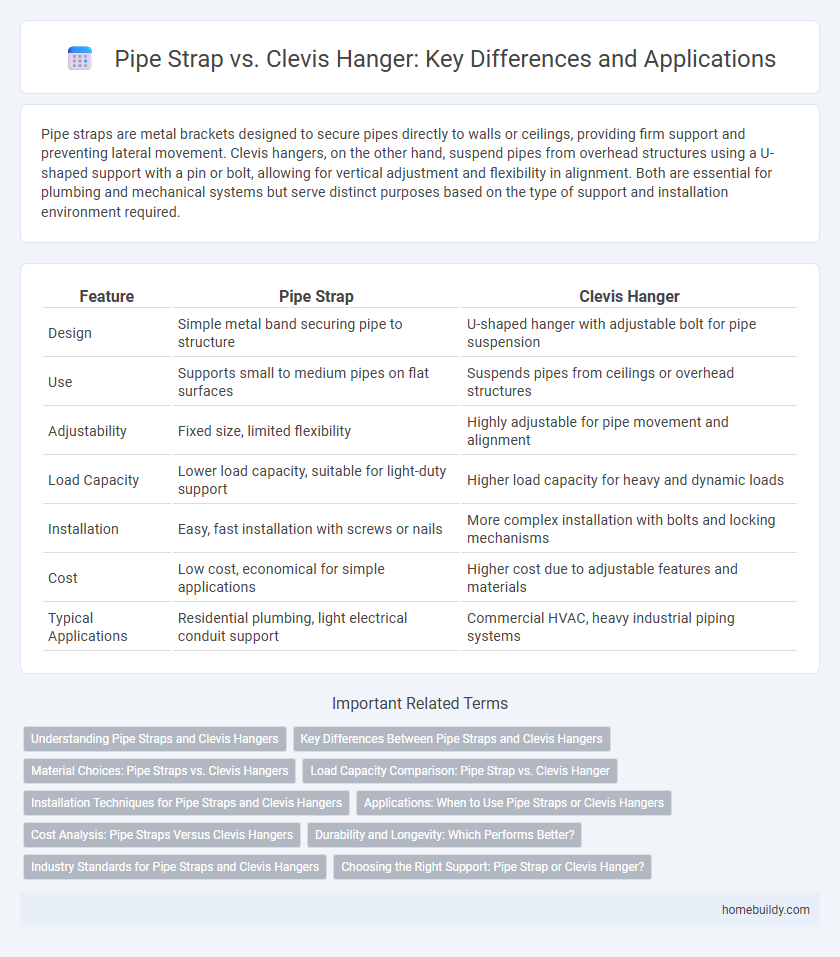Pipe straps are metal brackets designed to secure pipes directly to walls or ceilings, providing firm support and preventing lateral movement. Clevis hangers, on the other hand, suspend pipes from overhead structures using a U-shaped support with a pin or bolt, allowing for vertical adjustment and flexibility in alignment. Both are essential for plumbing and mechanical systems but serve distinct purposes based on the type of support and installation environment required.
Table of Comparison
| Feature | Pipe Strap | Clevis Hanger |
|---|---|---|
| Design | Simple metal band securing pipe to structure | U-shaped hanger with adjustable bolt for pipe suspension |
| Use | Supports small to medium pipes on flat surfaces | Suspends pipes from ceilings or overhead structures |
| Adjustability | Fixed size, limited flexibility | Highly adjustable for pipe movement and alignment |
| Load Capacity | Lower load capacity, suitable for light-duty support | Higher load capacity for heavy and dynamic loads |
| Installation | Easy, fast installation with screws or nails | More complex installation with bolts and locking mechanisms |
| Cost | Low cost, economical for simple applications | Higher cost due to adjustable features and materials |
| Typical Applications | Residential plumbing, light electrical conduit support | Commercial HVAC, heavy industrial piping systems |
Understanding Pipe Straps and Clevis Hangers
Pipe straps provide secure support by circling the pipe and fastening it directly to a structural surface, offering a low-profile solution ideal for horizontal piping. Clevis hangers suspend pipes using a U-shaped fastener and adjustable rods, allowing vertical support and flexibility for pipe movement or thermal expansion. Choosing between pipe straps and clevis hangers depends on load requirements, pipe size, and installation environment to ensure optimal pipe stability and longevity.
Key Differences Between Pipe Straps and Clevis Hangers
Pipe straps are metal bands that secure pipes directly to walls or beams, providing a simple, low-profile method for pipe support. Clevis hangers offer adjustable, suspended support with a U-shaped bracket and threaded rod, allowing for height customization and vibration isolation. Unlike clevis hangers, pipe straps do not allow vertical movement adjustment and are typically used for lighter, more rigid installations.
Material Choices: Pipe Straps vs. Clevis Hangers
Pipe straps are commonly made from materials such as galvanized steel, stainless steel, and sometimes plastic, offering corrosion resistance and strength for securing pipes to walls or ceilings. Clevis hangers are typically constructed from carbon steel or stainless steel, often featuring a protective coating like zinc plating to enhance durability in heavy-duty applications. The choice of material for pipe straps and clevis hangers depends on environmental conditions, load requirements, and the type of piping system being supported.
Load Capacity Comparison: Pipe Strap vs. Clevis Hanger
Pipe straps typically offer lower load capacity compared to clevis hangers, making them more suitable for lighter piping systems. Clevis hangers are engineered to support heavier loads and provide superior stability, especially in industrial and commercial applications. Selecting between these depends on weight requirements, with clevis hangers favored for heavy-duty pipe support.
Installation Techniques for Pipe Straps and Clevis Hangers
Pipe straps are installed by wrapping around the pipe and securing directly to a structure using screws or bolts, offering a straightforward and quick mounting process suitable for light to medium loads. Clevis hangers require threading the pipe through the hanger before fastening to the structure, providing adjustable vertical support ideal for heavier pipes and precise alignment. Choosing between pipe straps and clevis hangers depends on load requirements and installation complexity, with pipe straps favored for simplicity and clevis hangers for adjustability and heavy-duty support.
Applications: When to Use Pipe Straps or Clevis Hangers
Pipe straps are ideal for securing pipes in walls, ceilings, and studs where heavy load support is not critical, commonly used in residential plumbing or electrical conduit installations. Clevis hangers provide robust support for horizontal pipes in commercial or industrial settings, especially for heavier pipes that require load-bearing stability and vibration resistance. Selecting between pipe straps and clevis hangers depends on pipe size, weight, and environmental demands, with clevis hangers favored for heavy-duty and large-diameter pipe applications.
Cost Analysis: Pipe Straps Versus Clevis Hangers
Pipe straps generally offer a more cost-effective solution compared to clevis hangers due to their simpler design and lower manufacturing costs. Clevis hangers, while more adjustable and suitable for heavier pipes, involve higher material and installation expenses. For projects prioritizing budget constraints without compromising basic pipe support, pipe straps present a financially advantageous option.
Durability and Longevity: Which Performs Better?
Pipe straps are typically made from galvanized steel or stainless steel, providing strong resistance to corrosion and mechanical wear, which enhances their durability in various environments. Clevis hangers, constructed from heavier gauge steel with protective coatings, offer superior load-bearing capabilities and long-term stability, particularly in high-stress applications and fluctuating thermal conditions. While pipe straps excel in simplicity and resistance to basic wear, clevis hangers generally outperform in longevity due to their robust design and ability to accommodate pipe movement without compromising structural integrity.
Industry Standards for Pipe Straps and Clevis Hangers
Pipe straps comply with standards such as ASTM A36 and MSS SP-58, ensuring high tensile strength and corrosion resistance for secure pipe support. Clevis hangers conform to ASTM A36 and MSS SP-69, designed for adjustable and load-bearing pipe suspension in various industrial applications. Both fittings meet ANSI and ASME codes, critical for maintaining pipe integrity and safety in mechanical and plumbing systems.
Choosing the Right Support: Pipe Strap or Clevis Hanger?
Choosing the right support between pipe strap and clevis hanger depends on the weight and type of the pipe system. Pipe straps are ideal for lightweight to medium pipes, providing secure, direct attachment to the structure, whereas clevis hangers offer adjustable support suitable for heavier pipes or those requiring precise alignment. Understanding load requirements, pipe diameter, and installation environment ensures optimal stability and longevity of the piping system.
Pipe strap vs Clevis hanger Infographic

 homebuildy.com
homebuildy.com